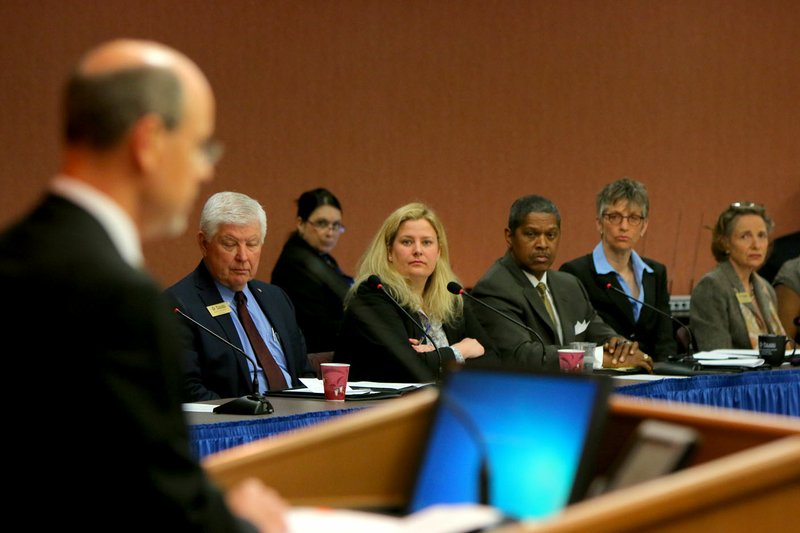The clock started ticking Monday -- and it's up to the Pulaski Technical College board of trustees to make the next move.
Trustees will weigh all the facts before deciding on a proposed merger of the college and the University of Arkansas System, board Chairman Ronald Dedman said.
He closed out the first public conversation Monday between the two parties after several questions about the viability of what could become three UA System entities in the metro area.
"This conversation today starts the shot clock for us," he said. "I will tell you that we won't take forever in making a decision, but I will also tell you that we won't rush to judgment. I will tell you that the folks that were here that sat in these seats before us and us, in the future, will make sure that the identity of this school is paramount.
"We will continue to work for and make sure that Pulaski Tech is the Pulaski Tech that we have all grown to know and love. We're going to continue to fight that fight."
Trustees for the North Little Rock community college -- along with school faculty, staff and community members -- on Monday heard UA System President Donald Bobbitt's proposal to merge Pulaski Tech into the state's largest higher-education system. It marked the first time the board officially considered such a proposal.
The presentation comes at a time when Pulaski Tech is facing declining enrollment and falling revenue from tuition and fees. Trustees, who did not make a decision on the merger Monday, will next week take up a recommended double-digit tuition increase -- the second consecutive one -- for its students in the 2016-17 school year.
On Monday, Bobbitt described the challenges the state's higher-education institutions are facing and what the UA System is doing to address them.
"It is a time when two forces -- technological advances and rapidly rising college costs -- are causing us to substantially rethink the way we both deliver and finance higher education," Bobbitt said. "In regard to technology, we are becoming increasingly aware that the rise of online education is now a fundamental part of the higher education portfolio, not only for fully online institutions but also for traditional two- and four-year schools that are searching for the best ways to serve our students."
On the financial end, Bobbitt said higher-education funding has entered a prolonged stagnant or declining phase, both on the state and the federal level. Colleges and universities in Arkansas aren't seeing the large cuts out-of-state peer institutions have faced, he said. Still, the state's schools have had to shave costs and find ways to be more efficient.
"So it's clear that we are facing an environment for the foreseeable future in which public investment in higher education will remain on the decline and we simply can't significantly raise tuition to make up for it or we will price our students out of the education they so desperately need," he said.
Bobbitt said all institutions, from private research universities to community colleges "must take a hard, strategic look at themselves and their strengths and weaknesses to decide where best to focus their time and efforts in a way that ensures a stable future."
Bobbitt spelled out the areas of assistance that the UA System could bring to Pulaski Tech: legal, financial, internal audit, academic affairs, communications and government relations.
He also listed collective expertise that is shared among its 18 campuses, divisions and administrative units, and the collaborative efforts to adapt and adopt new technologies, including a systemwide learning management system called Blackboard, and real-time data on student learning through a higher-education data analytics company.
It would ease the process for students transferring from Pulaski Tech to other UA System schools, he said, including the nearby University of Arkansas at Little Rock. UALR spokesman Allen Hicks said that during the past five years, the average annual number of students transferring from Pulaski Tech to UALR was 592, or about a third of the average annual number of students transferring to the school.
Addressing Trustee Kent Walker's questions about raising tuition to a level similar to other UA System schools, Bobbitt said his board is also concerned about pricing students out of the market. The UA System trustees review how a proposed tuition rate compares with its peer institutions within state and in neighboring states, and they carefully scrutinize most tuition increases, he said.
Currently, Pulaski Tech and Arkansas State University-Mid-South in West Memphis have the second-highest tuition rates for public two-year schools in the state at $110 per credit hour.
Northwest Arkansas Community College in Bentonville charges the most at $122.50 per credit hour. But the tuition rate for Northwest Arkansas Community College students who graduate “in-district” or from Rogers or Bentonville school districts is $75 per credit hour.*
The UA System's online-only university, eVersity, charges a tuition rate in between the highest community college rate and the lowest four-year school at $165 per credit hour.
Jason Green, Pulaski Tech's director of academic technology, said the college's demographics are much closer to those of eVersity than some of the other UA System schools. He asked Bobbitt about the relationship like between eVersity and other UA System schools' online presence.
The UA System's traditional colleges and universities still focus on the "in-the-seat" student, even with online classes, Bobbitt said. Those schools' online courses are for the traditional students who can't make it to class five days a week, while eVersity is for those who can't make it to the campus at all, he said.
The eVersity will also live and die on its tuition dollars. It's priced so that it's still economically advantageous for a student to study at a two-year college rather than the online-only university, he said.
Pulaski Tech Trustee Tamika Edwards and Dr. Martha Eshleman, an instructor of anatomy and physiology, asked whether a merger meant cutting the current number of faculty and staff members.
"Will they maintain their jobs?" Edwards asked. "What does the transition look like?"
The state's budgeting system gives each higher-education institution a separate appropriation bill, Bobbitt said.
"We do not micromanage in that regard, but we do insist that the budget be balanced and that we don't deficit spend," he added. "I think the key thing here is that would be a campus decision, but if it goes in that direction, to some extent, it destroys the relationship that exists between institution and students that you serve."
The college could face layoffs whether or not it joins the UA System or any other system, he said. College officials have said that if the board decides on a smaller tuition increase at its meeting on Monday, it could lead to layoffs.
Many of the college's trustees and employees also questioned whether Pulaski Tech -- the college, its faculty and staff and its programs -- would still be needed if it joined the UA System. Mostly, could it coexist with UALR just across the river?
"Each of our institutions retains a unique focus, a unique mission, a unique name and their traditions. We've never thought of one institution as being brought within another. But actually all institutions are part of the University of Arkansas System, and the board that I report to feels exactly the same."
And duplicate programs at both schools? asked Ben Peacock, the college's director of Allied Health Affiliations.
There's a rationale for duplicate programs at the undergraduate level -- even at close proximity, Bobbitt said. Technical programs, he said, are equally important to meeting the needs of students and the business community.
Dedman said he's seen plenty of change in his years on the board of trustees.
"The number of students that we educate has changed -- up and down, up and down," he said. "The way that we educate those students has changed over time as well. Our leadership here at the college has changed. We have a new president, and trustees have changed over time. I think it's safe to say that higher education has changed and will continue to evolve with the goal in mind of how to better educate the students of Arkansas.
"And what that means to me is that we, here at Pulaski Technical College, need to explore every option and turn over every rock looking for the best way to educate our students so that when they leave us, they are successful contributors and are able to provide a positive quality of life for themselves and for their family."
Metro on 03/29/2016
*CORRECTION: The tuition rate for Northwest Arkansas Community College students who graduate “in-district” or from Rogers or Bentonville school districts is $75 per credit hour. The college charges out-of-district, in-state students $122.50 per credit hour. This article incompletely described the tuition rate at the college.


